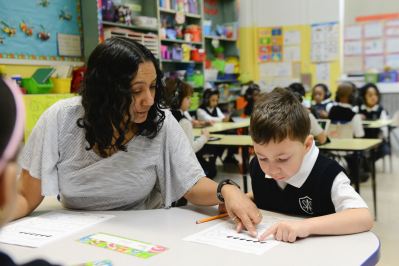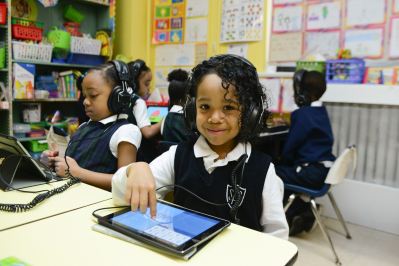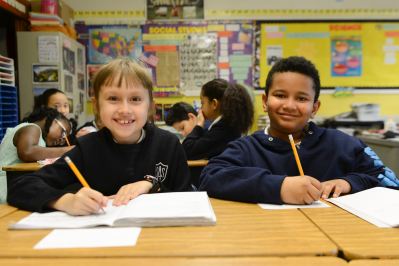“St. Ann, The Personal School” Lives Up to Its Name
Authors Note: Beginning in the 2020-2021 academic year, St. Ann, The Personal School and St. Paul School have combined to form the Academy of St. Paul & St. Ann.
For the past three years, St. Ann, The Personal School has been at the forefront of bringing personalized learning into the classroom. With the benefit of modern technology, every teacher now delivers student-centered instruction and every child has a customized academic plan. Faculty employ a “station-rotation” model, and use data generated by Blended Learning software to evaluate student proficiency, create individual academic plans, and design small group lessons. Student behavior, self-confidence, and test scores have improved dramatically under the new method. Through the innovative use of technology, St. Ann has proven how effective personalized instruction can be, even for disadvantaged populations.
In her first year as Principal, and with the support of her faculty, Hope Mueller took the bold step of rebranding St. Ann School as “St. Ann, The Personal School.” A fixture in East Harlem since 1926, St. Ann had a long tradition of establishing a personal relationship with each child and their family. Rebranding as “The Personal School” was a way to recognize its heritage as a small community school, while also signaling its commitment to a new instructional approach.
For the past three years, St. Ann has been at the forefront of bringing personalized learning into the classroom. With the benefit of modern technology, every teacher now delivers student-centered instruction and every child has a customized academic plan.
Over its 90-year history, St. Ann School had transitioned from a neighborhood, parish school to one that attracted students from across Upper Manhattan and the Bronx, 30% of whom were not Catholic. What drew families to the school was the faculty’s commitment to treating each student as an individual.
By 2014, the school faced declining enrollment, classroom behavioral problems, and stagnant test scores. “We knew we needed to try something different” says Ms. Mueller. “We knew we weren’t meeting the needs of every student as well as we could.”
Ms. Mueller had attended a few conferences where Blended Learning was featured, and was intrigued by the approach. She thought that the use of modern technology in the classroom, and most importantly the use of the data it generated, could help each faculty member better instruct each student. Ms. Mueller brought the idea to the faculty and they agreed it was worth trying.
St. Ann piloted a Blended Learning program in 2014-15 and implemented a school-wide rollout the following year. The faculty decided to use a “station-rotation model,” in which students would rotate through three centers:
- Station 1: Direct instruction with their teacher
- Station 2: Collaborative learning with a small group of peers
- Station 3: Individual learning on iPads or Chromebooks
The great benefit of the Blended Learning method is that software provides instant feedback on what students do and do not understand. Each week, teachers have a “data day” to review this feedback and plan their instruction. They divide students into groups based on similar needs, reviewing key concepts with students who have not mastered them and pushing others ahead to new challenges.
The diagnostic reports from the Blended Learning software also help teachers to evaluate student proficiency against each core standard. Teachers have conferences with every student to share their progress and create a customized academic plan. In addition, reports help communicate proficiency to parents and ensure continuity when students transition to the next grade.
Students have embraced the new technology and instructional methods. An eighth grader explains: “Now that we have Blended Learning you are getting it from two perspectives. You are getting it from the perspective of a computer, and you are getting it from the perspective of the teacher. For me, I learn from both.” A sixth grader has a similar view: “I like this change in teaching style, because when we didn’t have Blended Learning sometimes I wouldn’t understand a specific lesson and then it would be hard for me to move on. The Chromebooks see what level you are on and they help you reach the level where everyone else is.”
After two years of implementation, the results at St. Ann have been remarkable. On the social and emotional side, self-confidence is up, behavioral issues are down, and students are thriving in an environment that recognizes and delivers the individual attention they need. The experience of one eighth grader has been typical: “Blended Learning has made me more eager to come to school and learn, and has made me more confident in my answers.”
On the academic side, the faculty is proud of the results their students have achieved in a short period of time. St. Ann is a true inner-city school that is classified as being 100% below the poverty line. Its students are 99% minority, many are ELL and/or have diagnosed learning disorders, and fully 50% of St. Ann students are IEP or Title 1 qualified.
However, after just one year of Blended Learning implementation, the proportion of students in grades 3-8 who achieved proficiency on the New York State exam increased by 28% in ELA and 5% in Math. In 2017, the second year of Blended Learning implementation, student progress continued at an impressive rate.
When the subject of test results come up, Ms. Mueller likes to stress that “we are teaching to the student, not teaching to the test. If we do that, the results will show up in their test scores naturally.”
Seeing their students make so much progress has been extremely gratifying for St. Ann teachers. As fifth grade teacher Phil Biondo explains: “For years, I've known (and heard) that data and differentiation should lead my instruction. While I had some tools to individualize instruction, I always felt that what I was teaching my students wasn't specific enough and not really meeting their needs. With the Blended Learning intervention approach, I am able to pinpoint what deficiencies my kids have and in what areas they excel. I can now work with them on their weaknesses and challenge them on skills they have already mastered. For the first time in all my years of teaching, I feel like I'm genuinely individualizing my instruction to bridge gaps and make my students feel like I'm their personal teacher, tutor and mentor.”
However, the transition to Blended Learning has not always been easy, and it certainly was not cheap. Faculty had to invest many hours adapting to the new instructional methods. For example, every teacher had to change their class layout as well as learn how to form subgroups, transition students between stations, and analyze data to create individual lesson plans. The shift has also required over $200,000 in grants to fund the required technology and staff resources. St. Ann has made large investments in new Wi-Fi infrastructure, smartboards, age appropriate devices (e.g., iPads and Chromebooks), diagnostic software, tech coaching, and faculty professional development.
Although it has been costly, neither the faculty nor Ms. Mueller regret their decision to implement Blended Learning. At a school-wide level, trends have been reversed and enrollment has steadily increased year over year for the first time since 2006. In addition, St. Ann’s success has recently been recognized with three awards. In 2016, the school received New York Family Magazine’s prestigious Blackboard Award for Outstanding School. In 2017, it was the only Catholic school in the country designated as a “Top School to Visit” by Getting Smart. And in 2018, St. John’s University named Ms. Mueller a Distinguished Young Alumni for her commitment to advancing the field of education.
Although it has been costly, neither the faculty nor Ms. Mueller regret their decision to implement Blended Learning. At a school-wide level, trends have been reversed and enrollment has steadily increased year over year for the first time since 2006. In addition, St. Ann’s success has recently been recognized with three awards. In 2016, the school received New York Family Magazine’s prestigious Blackboard Award for Outstanding School. In 2017, it was the only Catholic school in the country designated as a “Top School to Visit” by Getting Smart. And in 2018, St. John’s University named Ms. Mueller a Distinguished Young Alumni for her commitment to advancing the field of education.
Perhaps most importantly, faculty and staff believe that implementing the new instructional method has been essential to fulfilling the mission of the school, which is: “to prepare students to take their place in the world, because every child has a special purpose in the eyes of God”.
In keeping with that mission, St. Ann has been generous in sharing its experiences, good and bad, with as many educators as are interested. Ms. Mueller has personally conducted Open House and focus groups for more than 200 educators from across New York City, the United States, and Canada. As she says, “We are happy to share our experience with everyone, because we want every child to develop their talents to the fullest, no matter where they go to school.”
Through the innovative use of technology, Ms. Mueller and her faculty have transformed teaching within St. Ann and have proven how effective personalized instruction can be, even for disadvantaged populations. After three years of the new Blended Learning method, St. Ann is truly living up to its name as “The Personal School”.









